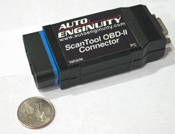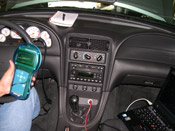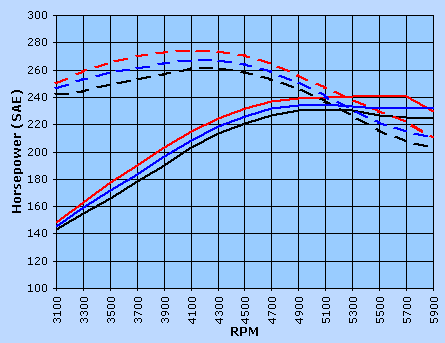|
Dyno Testing
We headed to our dyno affiliate Custom Dyno Tuning in
Hayward, California to spend the day with owner Arlee Taylor
testing out the effects of
the Predator tuner. Arlee's shop does considerable late-model
tuning, Fords and otherwise, but is actually an SCT dealer.
SCT (Superchips Tune)
is Diablosports competitor, so naturally Arlee had some interest
in seeing how well the Predator performs. We made nearly a
dozen pulls ranging from the factory 2001 GT tune to the Predator's
performance tune, as well as our own variations of both tunes
using the units ability to adjut air-fuel ratio and timing.
Our test pony has a fairly stock 4.6L 2V motor, with the only
modifications being an off-road
X-pipe, Plasma Booster ignition, and aftermarket upper
plenum.
We had installed the Predator tune to the vehicle several
days prior to
 While the Predator has some data-logging
capability, for serious OBD-II data analysis we prefer
using Auto Enginuity's
OBD-II scan tool. This professional grade logger enabled
us to ensure each dyno pull was made under consistant
engine conditions. Look for a full review soon.
While the Predator has some data-logging
capability, for serious OBD-II data analysis we prefer
using Auto Enginuity's
OBD-II scan tool. This professional grade logger enabled
us to ensure each dyno pull was made under consistant
engine conditions. Look for a full review soon. |
our dyno session in order to compensate
for any "learning" the PCM might
do as a result of the new parameters. The idea that the computer
needs to spend some amount of time adjusting to new modifications
is a shaky concept used sparingly by many late-model owners
and tuners. While we certainly have witnessed a late-model
Mustang perform better several days after bolting on a modification,
we have however never seen this tested this in a controlled
environment. The plausible explanation is that some modifications,
particularly those effecting the air flow into the motor,
result in immediate short-term fuel trim changes as the PCM
tries to compensate for the different air-fuel ratio feedback
from the O2 sensors. Over time these short-term fuel trim
changes are incorporated into the engines long-term fuel trim
strategy, hence resulting in some variance in overall performance.
Again, this sort of "learning" probably does occur
but we haven't spent any considerable time analyzing to what
extent.
Our first pulls on the dyno were therefore

We made tuning changes from the
cockpit using the Predator's LCD interface. |
with the Predator performance tune
as delivered in the unit. We then reinstalled the factory tune
and made additional pulls. This was followed by reinstalling
the Predator tune and manually adjusting the air-fuel ratios
to various stages of lean in order to approach 13.0:1 at wide-open
throttle. Finally our last pull was with the PCM flashed back
to the as-delivered Predator tune. This would give us a chance
to compare the effects of the Predator tune when the car has
had several days to "learn" it, versus immediately
loading the tune and making a dyno pull.
The Results
With the PCM tuned as Ford delivered it, our normally aspirated
4.6L 2V made 231 horsepower and 262 ft-lbs of torque. For those
who are already comparing our numbers to their '99-'04 GT keep
in mind that load-bearing dynos such as the Mustang Dyno operate
differently than inertia-only dynos such as the Dynojet 248.
Look for an FM original article soon on the differences between
various chassis dynos. For now it is important to realize Mustang
Dyno numbers tend to be slightly less than Dynojet figures,
as they reflect true load conditions on the vehicle, such as
air resistance at speed. The key in any dyno testing is comparing
apples to apples and looking at the differences using the same
measuring equipment.
| Dyno Results:
2001 Mustang GT, 4.6L 2V |
| Dyno Type: Mustang
Dyno MD-1100 (Custom Dyno Tuning, Hayward,CA) |
|
|
Pull
|
Horsepower Peak
|
Torque Peak
|
|
|
Factory
Tune |
231@5150
|
262@4150
|
|
|
Predator
Tune |
234@5600
|
268@4150
|
|
|
Predator
Tune
+ max advance |
241@5550
|
275@4150
|
|
|
|
 |
With the PCM flashed with the as-delivered
Predator tune the numbers improved to a peak of 234 horsepower
and 268 ft-lbs. While initially this seems to be hardly a
significant gain, take a closer look at the charts. Horsepower
with the stock tune (black) peaks out at 5150 rpm and then
drops off. Horsepower with the Predator is 232 at 5150 and
it continues to rise up to 234 at 5600 rpm and pulls to 5900
without dipping below 233 HP. In fact, horsepower with the
Predator is up 3-5 points all across the rpm range. Torque
increased 4-6 ft-lbs from 3300-4500 rpm.
Looking at the data from our wideband
O2 sensor we still felt engine was rich. With the factory
tune our '01 GT would approach 12.0:1 A/F at wide open throttle.
With the canned Predator tune the ratios are leaned up slightly
to 12.5:1. We used the Predator's parameter edit mode to further
lean out the the A/F ratio in small increments. The Predator
enables adjustments of the A/F ratio up to 15% leaner and
40% richer than stock. Surprisingly the engine didn't respond
at all to a leaner A/F ratio. We went in steps from 12.5:1
to 12.8 to 13.0 and the power actually dropped 1-2 HP across
the board. It appeared that the Predator tune was as good
as it was going to get, and that was only a handful of horsepower
and torque above stock.
Is there more?
Not fully convinced that a 4.6L 2V delivered from the factory
with pig rich A/F ratios has only 5 horsepower to be found
from tuning, we emailed the guys at Diablo with our numbers.
They indicated that these gains are about what they see on
normally aspirated GT's, but suggested going back to the dyno
and maxing out the spark advance. The Predator allows for
up to 10% more advance over stock and 40% retard from the
stock set point. We followed their advice and sure enough
that is is where the hidden power was. We picked up an additional
7 horsepower and torque over the canned Predator tune. Overall
were achieved average gains of 10 horsepower and 12 ft-lbs.
over the factory tune. What is more impressive are the gains
at every rpm point in the power band. With the Predator tune
the motor pulls 400-500 rpm beyond the factory peak horsepower
point. With the added timing advance on top of the canned
Predator tune we gained as much as 16 ft-lbs of torque below
4000 rpm. Of course with the added timing you must run the
high pump octane. We have encountered no pinging so far with
91 octane in the tank. That might change during the summer
months however.
Conclusion
When it comes down to it, all performance mods must be
rated on a horsepower to dollar scale. The Predator at around
$400 for 12 horsepower is a pretty good deal as is. In fact
while not represented in this article we've seen double those
gains on supercharged GT's as well as the 4V Cobra's. Add
in all the other cool cost saving features, such as a built
in speedometer adjustment, downstream O2 sensor control, code
scanner and data-logger and you have easily covered the costs
for buying those products individually. 
|

